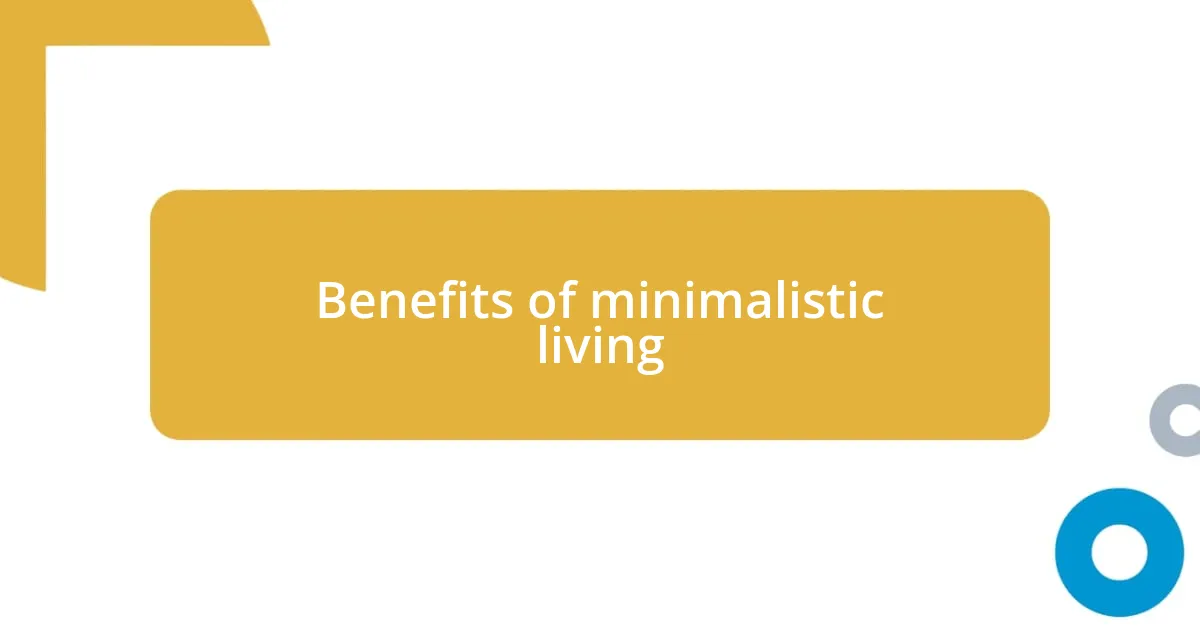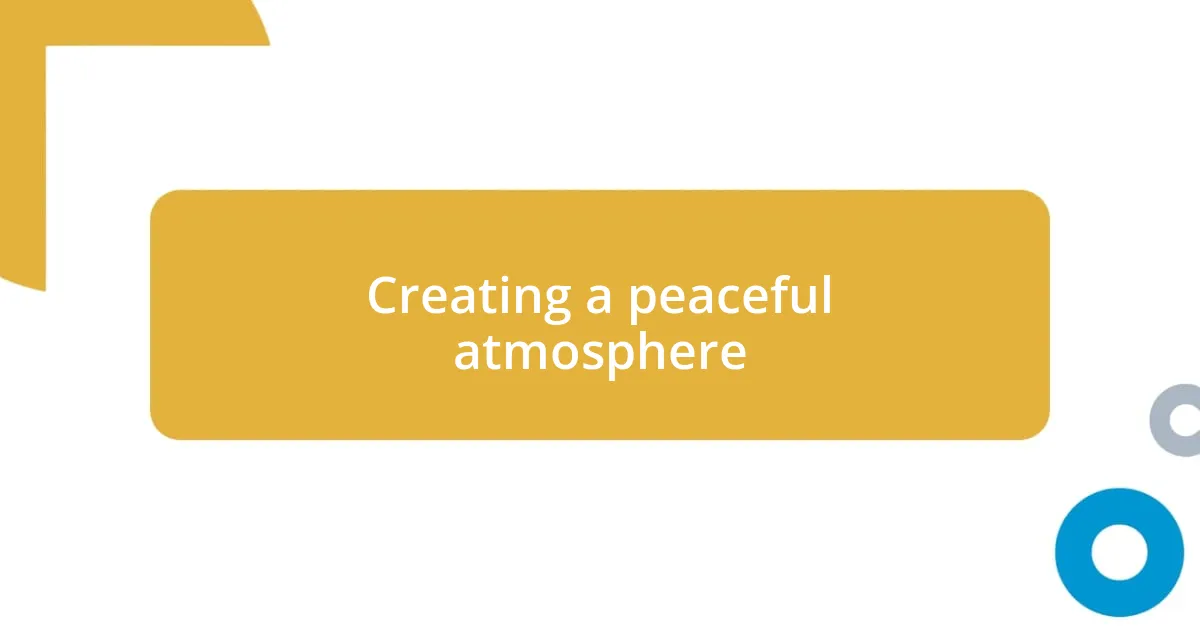Key takeaways:
- Minimalistic living goes beyond decluttering; it promotes intentionality, mindfulness, and a reassessment of our relationship with possessions.
- Key benefits include reduced stress, financial freedom through prioritizing experiences, and fostering sustainability by making conscious choices about what we own.
- Essential principles of minimalism involve choosing quality items, intentional living, clarity in spaces, and embracing functional aesthetics.
- Creating a peaceful atmosphere can be achieved through soft lighting, decluttering, and incorporating soothing scents to enhance relaxation.

Understanding minimalistic living
Minimalistic living is about more than just decluttering; it’s a lifestyle that encourages you to prioritize what truly matters. I remember the first time I decided to tackle my overflowing closet. The process felt liberating—I was amazed at how each item I let go of brought a sense of clarity, causing me to reflect on what I truly valued.
At its core, minimalism invites us to reassess our relationship with possessions. Have you ever noticed how a cluttered space can weigh heavy on your mind? I found that simplifying my environment diminished distractions, allowing more room for creativity and mindfulness. It’s like taking a deep breath in a serene landscape; everything feels lighter.
Embracing minimalistic living fosters a sense of intentionality in our daily choices. When I replaced my crowded surfaces with just a few meaningful items, I began to appreciate the beauty in simplicity. Have you ever stopped to consider how less really can be more in our fast-paced world? It’s a perspective shift that transforms not just our spaces, but also our lives.

Benefits of minimalistic living
Living in a minimalistic space can significantly reduce stress and anxiety. I discovered this firsthand when I transitioned from a busy, cluttered home to a more streamlined environment. It felt like lifting a weight off my shoulders, similar to stepping out of a chaotic subway station into a quiet park. The simplicity created in my surroundings allowed for a peaceful mind—less chaos visually translates to less chaos mentally.
Another remarkable benefit is how minimalism encourages financial freedom. I used to find myself continually purchasing items I didn’t need, but as I practiced minimalism, I began to invest in experiences rather than things. For instance, instead of spending on that trendy gadget, I opted for a weekend hiking trip. This shift not only saved me money but enriched my life with memories that truly matter, showcasing how minimalism aligns with a richer experience.
Lastly, the beauty of minimalistic living lies in cultivating sustainability. As I learned to embrace fewer possessions, I naturally became more conscious of what I brought into my home. It’s like going on a first date with nature; the more you understand it, the more you respect it. By prioritizing quality over quantity, I found myself making eco-friendly choices, reducing waste and recognizing that every item I own can have a purpose.
| Benefit | Description |
|---|---|
| Reduced Stress | Minimalism creates a calmer environment, leading to decreased anxiety and mental clarity. |
| Financial Freedom | Emphasizing experiences over possessions can save money and create richer life moments. |
| Sustainability | Focusing on fewer quality items fosters environmentally-conscious choices. |

Key principles of minimalism
Minimalism revolves around a few fundamental principles that shape both our spaces and our perspectives. One key tenet is intentional living, where every item in your home serves a purpose or brings you joy. I recall a moment when I decided to part with my collection of mismatched kitchen gadgets. Each time I opened the drawer, it felt like a chaotic buffet of unused tools. Letting go of them not only cleared the clutter but also inspired me to cherish the few, high-quality pieces I did keep.
Here are some key principles of minimalism:
- Less is More: Prioritize quality over quantity in your possessions.
- Intentionality: Choose items that matter and skip the impulse buys.
- Clarity: A tidy space promotes a clearer mind, making way for creativity.
- Functional Aesthetics: Every piece should have a purpose, blending beauty and utility.
Another essential aspect is mindfulness, which emphasizes being present and appreciating what you have. I often find myself captivated by the simplicity of a single, beautifully crafted chair in a room rather than overwhelmed by a multitude of furnishings. This shift allows me to experience my space in a more profound way. By focusing on fewer, purposeful items, I’m not just clearing surfaces; I’m enhancing my life with greater meaning and connection to my surroundings.
- Mindfulness: Cultivate awareness of how your surroundings affect your mood and thoughts.
- Simplicity: Strive for a serene environment that nurtures peace and satisfaction.
- Sustainability: Make conscious decisions about what enters your life, promoting ecological harmony.
- Value Experiences: Invest in moments and memories instead of material possessions.

Tips for decluttering your space
One effective way to begin decluttering is to tackle one small area at a time. I remember when I focused on just my nightstand. Initially, it seemed daunting, but as I cleared away old receipts and unused chargers, I experienced an incredible sense of accomplishment. This small victory motivated me to keep going. Have you ever noticed how just clearing a little bit can create momentum?
Another tip is to apply the “one in, one out” rule. For every new item you bring home, consider removing an old one. This practice not only keeps clutter at bay but also encourages you to think critically about your purchases. I found this rule particularly helpful when clothes shopping; it made me more selective about what I truly needed versus what I simply wanted. Trust me, it feels rewarding to know that each new addition to your space has been thoughtfully considered.
Lastly, set a timer for 10-15 minutes and declutter as many items as you can in that time. This technique keeps the process manageable and even a bit fun! I often play my favorite playlist while doing this, turning an overwhelming task into a timed challenge. It’s surprising how much I can achieve in a short period. What about you? Have you tried making decluttering a more dynamic experience?

Choosing multifunctional furniture
When it comes to choosing multifunctional furniture, I often think of the invaluable role it plays in optimizing small spaces. For instance, investing in a sofa bed transformed my living room into a cozy guest space whenever friends visit. Isn’t it great when one piece serves multiple needs without sacrificing comfort or style?
In my experience, a dining table that doubles as a workspace can be a game-changer. I remember hesitating when I first considered a drop-leaf table, but it has since allowed me to host dinner parties and still have a productive workspace during the day. Have you ever wondered how much more spacious your home might feel if furniture could adapt to your life rather than the other way around?
Also, think about pieces with hidden storage. I once fell in love with an ottoman that not only looked stylish but also stored blankets and magazines. This small addition cleared up floor space and brought a sense of order to my home, proving that practicality and aesthetic appeal can coexist beautifully. Isn’t it time you considered how furniture could do more for you?

Simple decor ideas for minimalism
When it comes to simple decor ideas that embrace minimalism, I find that neutral color palettes make a substantial impact. A few months ago, I decided to repaint my living room in soft whites and beiges. The transformation was astonishing—everything felt calmer, and it allowed my plants and art pieces to genuinely shine. Have you ever tried using a neutral backdrop to enhance your favorite decor elements?
Another delightful idea is to incorporate natural textures. I remember replacing a heavy fabric curtain with light linen ones, which instantly brightened my space. The subtle movement of the fabric as the breeze comes in adds a gentle feel to the room. It made me realize how much I longed for simplicity—a perfect example of how a straightforward change can refresh your environment.
Lastly, showcasing a few meaningful pieces of art can elevate your minimalistic decor while still staying true to simplicity. I once curated a small gallery wall with just three framed photographs that evoke cherished memories. Each piece tells its own story while maintaining that uncluttered vibe. What do you love about hanging artwork that captures your experiences, creating a narrative without overwhelming the space?

Creating a peaceful atmosphere
Creating a peaceful atmosphere often starts with the right lighting. I’ve always favored soft, warm lights over harsh fluorescents, as they really set a tranquil mood. Recently, I switched to dimmable LED bulbs, allowing me to adjust the brightness depending on the time of day or my activity. Have you ever noticed how the ambiance can change drastically just by altering the light?
In my space, decluttering plays a crucial role in fostering serenity. I remember when I cleared out my bookshelf, removing items that no longer resonated with me. The moment I let go of those unnecessary distractions, I felt an innate calm wash over me. Does your environment sometimes feel chaotic because of things that you hold onto too tightly?
Finally, incorporating soothing scents can transform your living area into a sanctuary. A few weeks back, I discovered the joy of essential oil diffusers, filling my home with calming aromas like lavender or eucalyptus. Just a few drops can turn an average evening into a relaxing retreat. Have you found certain scents that bring you peace, making your space feel like a true haven?














